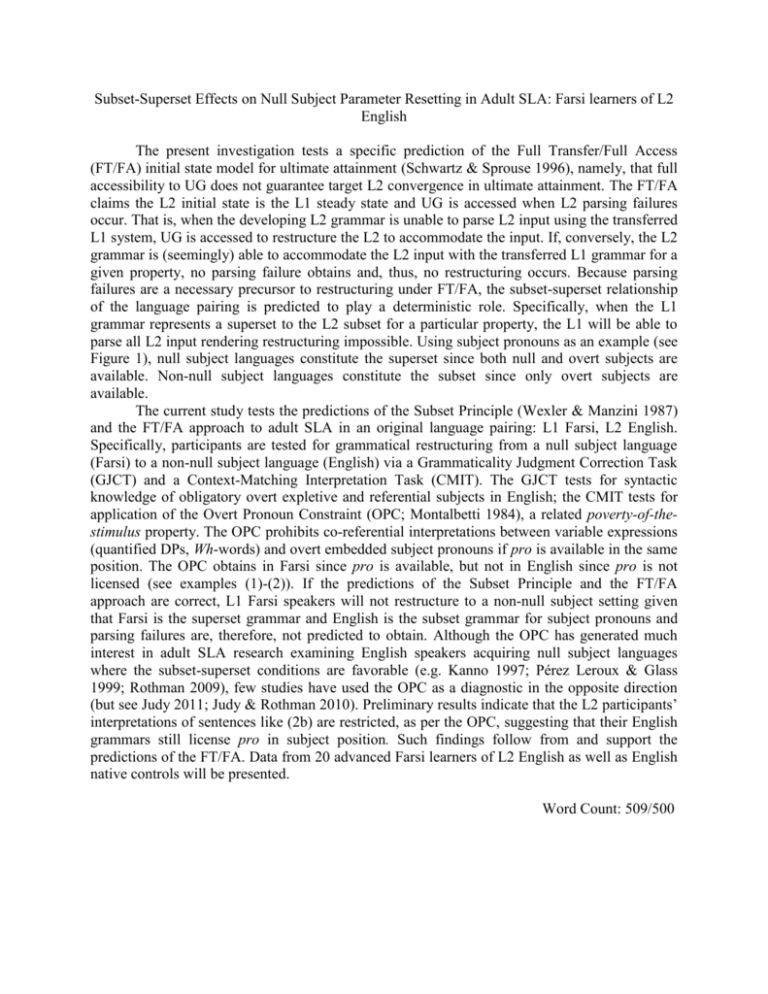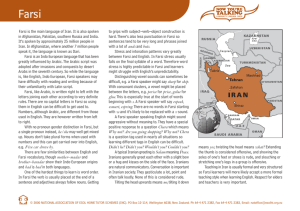Subset-Superset Effects on Null Subject Parameter Resetting in
advertisement

Subset-Superset Effects on Null Subject Parameter Resetting in Adult SLA: Farsi learners of L2 English The present investigation tests a specific prediction of the Full Transfer/Full Access (FT/FA) initial state model for ultimate attainment (Schwartz & Sprouse 1996), namely, that full accessibility to UG does not guarantee target L2 convergence in ultimate attainment. The FT/FA claims the L2 initial state is the L1 steady state and UG is accessed when L2 parsing failures occur. That is, when the developing L2 grammar is unable to parse L2 input using the transferred L1 system, UG is accessed to restructure the L2 to accommodate the input. If, conversely, the L2 grammar is (seemingly) able to accommodate the L2 input with the transferred L1 grammar for a given property, no parsing failure obtains and, thus, no restructuring occurs. Because parsing failures are a necessary precursor to restructuring under FT/FA, the subset-superset relationship of the language pairing is predicted to play a deterministic role. Specifically, when the L1 grammar represents a superset to the L2 subset for a particular property, the L1 will be able to parse all L2 input rendering restructuring impossible. Using subject pronouns as an example (see Figure 1), null subject languages constitute the superset since both null and overt subjects are available. Non-null subject languages constitute the subset since only overt subjects are available. The current study tests the predictions of the Subset Principle (Wexler & Manzini 1987) and the FT/FA approach to adult SLA in an original language pairing: L1 Farsi, L2 English. Specifically, participants are tested for grammatical restructuring from a null subject language (Farsi) to a non-null subject language (English) via a Grammaticality Judgment Correction Task (GJCT) and a Context-Matching Interpretation Task (CMIT). The GJCT tests for syntactic knowledge of obligatory overt expletive and referential subjects in English; the CMIT tests for application of the Overt Pronoun Constraint (OPC; Montalbetti 1984), a related poverty-of-thestimulus property. The OPC prohibits co-referential interpretations between variable expressions (quantified DPs, Wh-words) and overt embedded subject pronouns if pro is available in the same position. The OPC obtains in Farsi since pro is available, but not in English since pro is not licensed (see examples (1)-(2)). If the predictions of the Subset Principle and the FT/FA approach are correct, L1 Farsi speakers will not restructure to a non-null subject setting given that Farsi is the superset grammar and English is the subset grammar for subject pronouns and parsing failures are, therefore, not predicted to obtain. Although the OPC has generated much interest in adult SLA research examining English speakers acquiring null subject languages where the subset-superset conditions are favorable (e.g. Kanno 1997; Pérez Leroux & Glass 1999; Rothman 2009), few studies have used the OPC as a diagnostic in the opposite direction (but see Judy 2011; Judy & Rothman 2010). Preliminary results indicate that the L2 participants’ interpretations of sentences like (2b) are restricted, as per the OPC, suggesting that their English grammars still license pro in subject position. Such findings follow from and support the predictions of the FT/FA. Data from 20 advanced Farsi learners of L2 English as well as English native controls will be presented. Word Count: 509/500 (1a) Un mardi fekr mikonad ke ui/j az hameh betar-ast. (1b) Un mardi fekr mikonad ke proi/*j az hameh betar-ast. that man thought DUR-make-3.SG that he/pro from all better-be-3.SG.PRES ’That man thinks that he/pro is the best.’ (1c) Kii fekr mikonad ke u*i/j az hameh behtar-ast? (1d) Kii fekr mikonad ke proi/*j az hameh behtar-ast? who thought DUR-make-3.SG that he/pro from all better-be-3.SG.PRES ’Who thinks that he/pro is the best?’ (2a) The mani thinks that he i/j is the best dancer. (2b) Whoi thinks that he i/j is the best dancer? Figure 1: Subset-Superset Relationship of Farsi and English for the Null Subject Parameter Farsi (superset) (null & overt subjects) English (subset) (overt subjects) References Judy, T. (2011). L1/L2 parametric directionality matters: More on the Null Subject Parameter in L2 acquisition. EUROSLA Yearbook 11: 165-190. Judy, T. & Rothman, J. (2010). From a Superset to a Subset grammar and the Semantic Compensation Hypothesis: Subject Pronoun and Anaphora Resolution Evidence in L2 English. In BUCLD 34: Proceedings of the 34th annual Boston University Conference on Language Development, K. Franich, K.M. Iserman & L.L. Keil (eds.), 197-208. Somerville, MA: Cascadilla Press. Kanno, K. (1997). The acquisition of null and overt pronominals in Japanese by English speakers. Second Language Research 13(3): 265–287. Pérez-Leroux, A.T. & Glass, W. (1999). Null anaphora in Spanish second language acquisition: probabilistic versus generative approaches. Second Language Research 15: 220-249. Rothman, J. (2009). Pragmatic deficits with syntactic consequences?: L2 pronominal subjects and the syntax–pragmatics interface. Journal of Pragmatics 41: 951–973. Schwartz, B. & Sprouse, R. (1996). L2 cognitive states and the Full Transfer/Full Access Model. Second Language Research 12: 40-72. Wexler, K. & Manzini, R. (1987). Parameters and learnability in binding theory. In Parameter setting, T. Roeper and E. Williams (eds.), 41-76. Dordrecht: Reidel.










